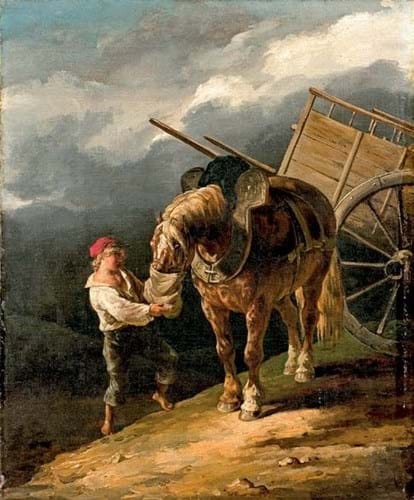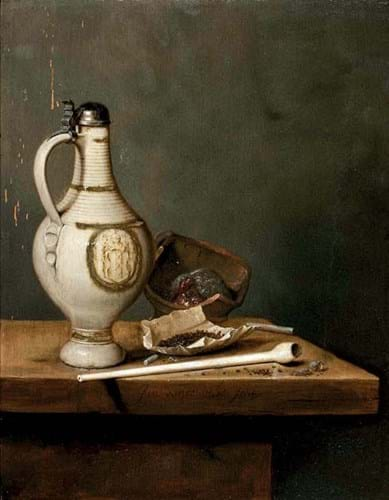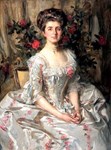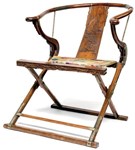
Among these are a flowering of Old Masters, either as stand alone sales or part of a classic mixed auction. Pictured here are two high-flyers from auctions held in June at the Drouot centre.
Géricault carthorse
While the Raft of the Medusa might be his most famous painting, the French artist Théodore Géricault (1791-1824) is also renowned for his equine subjects. Depictions of racehorses, arab stallions in combat or as portraits are common.
The example, above, offered by Beaussant-Lefèvre (20.83% buyer’s premium) in its sale of Old Master paintings and works of art at Drouot on June 15, was of an altogether more domestic nature. Garçon Donnant l’avoine à un cheval detélé shows a young boy feeding oats an aged carthorse untethered from its wagon.
The 17¾ x 14in (45 x 36cm) oil on canvas is dated to late in the artist’s career and various paper labels to the reverse of the frame give evidence of the painting’s earlier history. It was probably sold to Jean Schickler on Géricault’s behalf by a Colonel Bro in 1823 and then featured posthumously in the Paris Salon of 1824.
Passing from the Schickler family to the collection of Raoul Suchet, 3rd Duke of Albufera, and thence by descent, it was also exhibited at the Galerie Charpentier in 1924, a century after its appearance at the Salon.
A much-published work, it was also produced as a lithograph by Volmar. Last month in the sale at Drouot it doubled the estimate to take €280,000 (£247,790).
Dutch simplicity

Audap & Mirabeau sold this still-life by the 17th century Dutch artist Jan Jansz Van de Velde III for €670,000 (£592,920).
The following week, Audap & Mirabeau (21.5% buyer’s premium) chalked up a triple-estimate €670,000 (£592,920) for a classic spare still-life by the 17th century Dutch artist Jan Jansz Van de Velde III (1620-62).
The style and format of the work is typical of the artist’s oeuvre from the mid century until his death.
The strikingly simple vertical format composition features a German Westerwald stoneware armorial jug, or Wapenkruik, with the arms of the city of Amsterdam, tobacco in a paper, a clay pipe and a small brazier with a hot coal.
The small 14 x 11in (36 x 28cm) oil on panel, signed lower centre Jan Van de Velde Fecit and dated 1650 on the jug, had a wax seal to the reverse and some minor losses to the surface.
It had come from the collection of Vicomte Pierre Le Boucq de Ternas (1866-1948), passing down by descent to the vendor.














